7 Verified Solutions to Fix a Dimming or Darkening Screen on Your Samsung TV
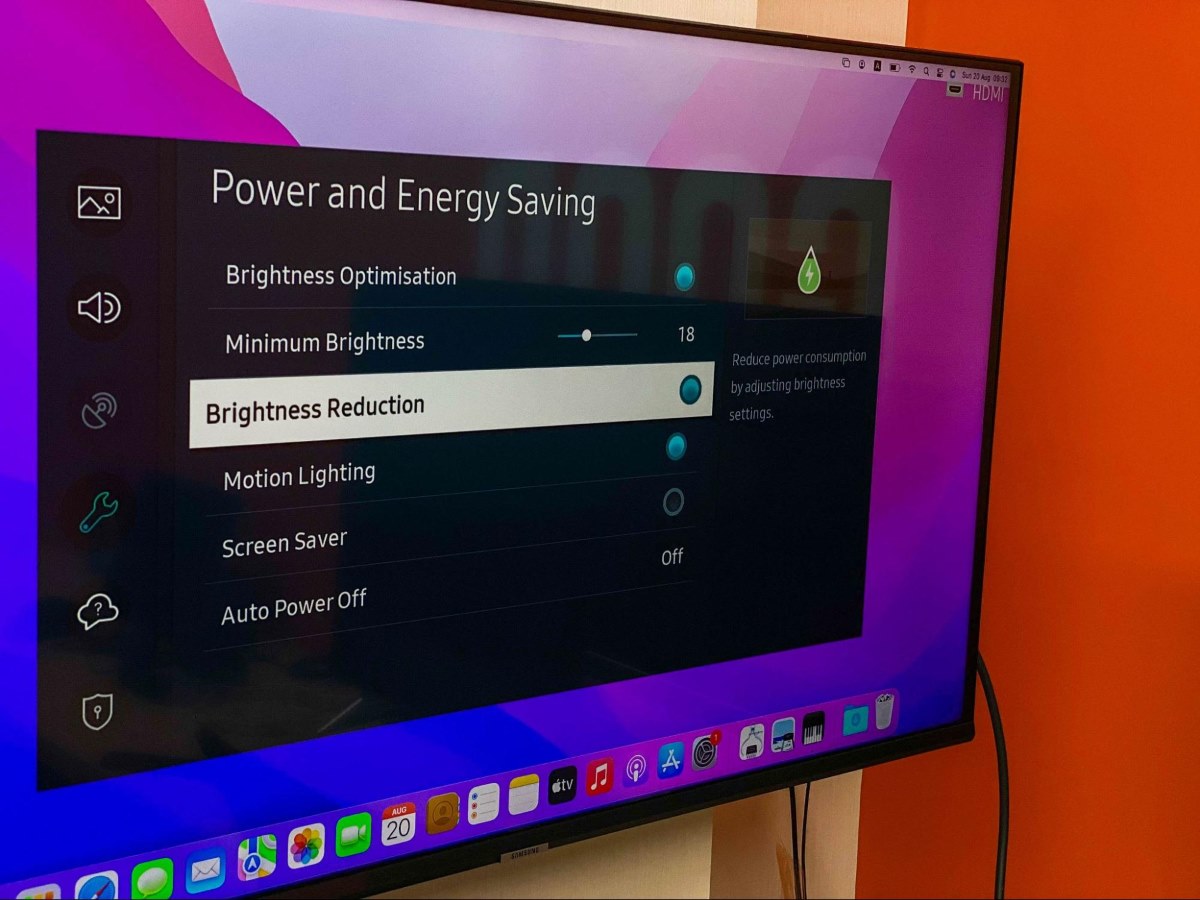
- Ambient light detection, contrast enhancer, brightness optimization, brightness reduction, and motion lighting features on Samsung TVs can cause unintended dimming or darkening; disabling these can improve screen brightness.
- Damaged backlights can lead to dimming issues; if under warranty, contact Samsung support, or consider replacing the backlight LED strips yourself if you’re technically experienced.
- External devices like laptops or streaming sticks may cause a Samsung TV screen to dim, especially with HDR content; adjusting the device settings or switching from HDR to SDR can help brighten the display.
In this guide, I’ll show you seven proven methods to fix a fading or deepening darkness on your Samsung TV’s display.
Let’s dive in!
Quick Navigation
1. Ambient Light Detection
Samsung TVs feature an ambient light detection sensor, which is labeled as an “ECO sensor” in older models. This handy function consists of a small sensor that measures the room’s brightness and adjusts the TV’s brightness accordingly.
Smartphones and tablets also have a similar feature often referred to as auto-brightness. This protects the users’ eyes and, theoretically, saves them the pain of adjusting the brightness manually.
However, the ambient light detection feature can sometimes cause the TV to be too dim or malfunction, dimming the TV during broad daylight.
So, if you find that your TV’s brightness is constantly fluctuating, it’s a good idea to disable it.
How to Disable Ambient Light Detection?
The instructions to disable the ambient light detection feature on Samsung TVs differ depending on when the TV was released.
You will need to disable this function through the TV’s settings using your TV remote.
Bear in mind that once this feature is disabled, you will need to manually adjust the brightness to see the TV in a light or dark room.
2016 Models and Below
Step 1: Navigate to System.
Step 2: Select Eco Solution.
Step 3: Then, head to Eco Sensor.
Step 4: Select Off to disable this feature.
2017 Models and Above
Step 1: Go to the Settings.
Step 2: Click on General.
Step 3: Go to Ambient Light Detection.
Step 4: Select the slider icon to toggle this setting off.
Watch the video below on how to disable Ambient Light Detection on Samsung TV 2017 models and above.
2. Contrast Enhancer
Similar to ambient light detection, the contrast enhancer tool also adjusts your screen’s brightness. However, instead of brightening or dimming the entire screen, it brightens/dims certain areas of the picture to ensure the light and dark areas are balanced.
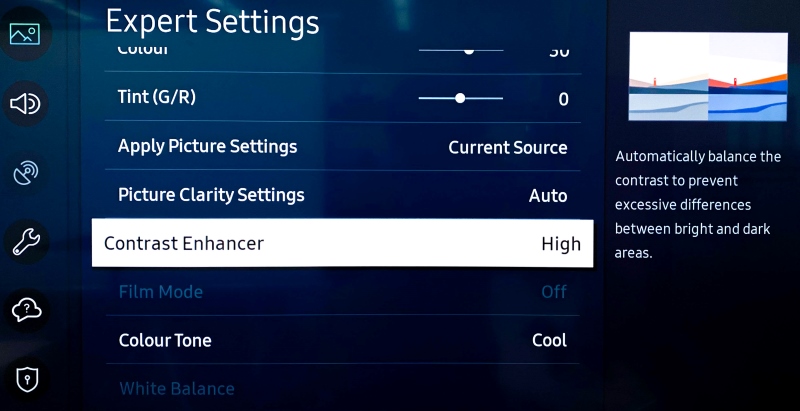
This ensures you can see the picture clearly, even during dark scenes.
While this function is usually useful, it can become troublesome if it continues to dim the screen. Alternatively, some film fanatics may find it bothersome as it adjusts the picture’s original contrast, changing a movie’s overall look.
Let’s learn how to disable it.
Step 1: Navigate to your Samsung TV’s Settings.
Step 2: Go to Picture.
Step 3: Head to Expert Settings.
Step 4: Toggle the Contrast Enhancer off.
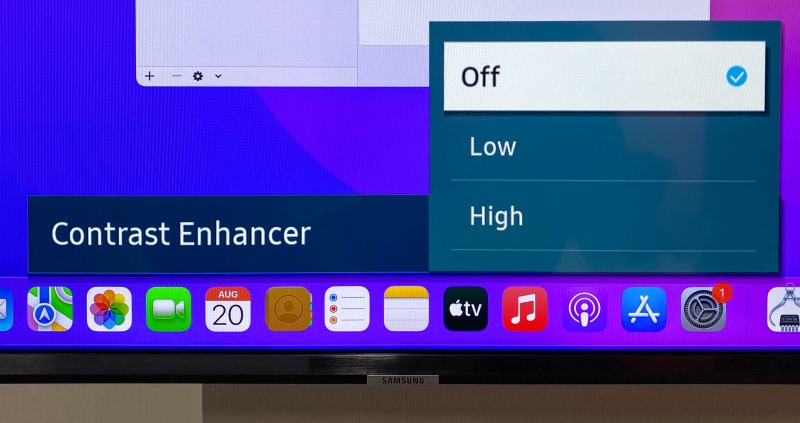
Watch the video below on how to set the Contrast Enhancer on Samsung TV.
3. Brightness Optimization
Brightness Optimization is very similar to ambient light detection. The main difference between the two is their names and the process to enable/disable them.
This feature also brightens and dims your TV screen to match the environment’s lighting, making it brighter when the room is bright and vice versa.
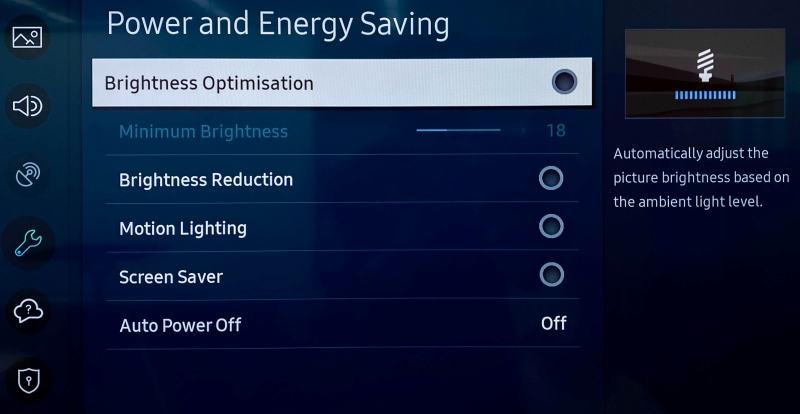
While this feature usually works well, the sensor can incorrectly asses your room’s brightness, making your TV unnecessarily dim. Additionally, different users have various picture preferences. So, while one person may love this function’s adjustments, others will find them unbearable.
Let’s learn how to turn off brightness optimization on a Samsung TV.
Step 1: Click on the Settings on the Home screen.
Step 2: Navigate to General.
Step 3: Then, select Power and Energy Saving.
Step 4: Go to Brightness Optimization and turn it off. You’ll know you’ve successfully disabled it when the indicator goes from blue to black/gray.
4. Brightness Reduction
Have you ever enabled low power mode on your iPhone or dimmed your laptop screen to preserve the battery? Brightness reduction accomplishes the same task on your TV, as it dims the screen to reduce its power consumption.
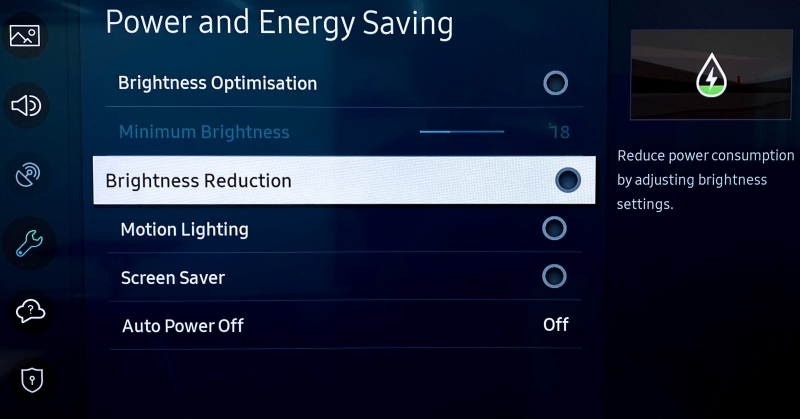
If you’re eco-friendly or budget-conscious, this is a great setting to enable, as it will conserve electricity.
This function does not adjust the brightness according to the room’s ambient.
However, one downside of this function is that it dims your TV screen, making it look darker and less vibrant.
While disabling this feature will increase your TV’s power consumption, it will also brighten the screen and enhance your viewing experience.
Step 1: Go to the Settings.
Step 2: Select the General option.
Step 3: Navigate to Power and Energy Saving.
Step 4: Go to Brightness Reduction and select it to turn it off. Once disabled, the indicator will be greyed out.
5. Motion Lighting
The last setting we suggest disabling if your Samsung TV keeps dimming is motion lighting. This function brightens or dims your TV depending on the picture’s movement. It will adjust the picture’s brightness when there is a lot of motion on-screen and then revert it to the original brightness once the image is still again.
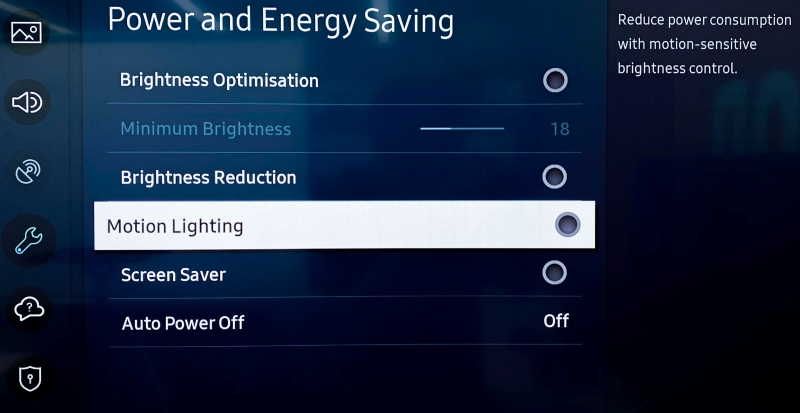
If you’ve ever gotten a headache from watching an action-packed film at peak brightness, then you’ll find the motion lighting function helpful. However, if you’re struggling to see the screen, it’s best to disable it.
Motion lighting also seeks to conserve energy, ensuring your TV does not consume tons of electricity while displaying fast-paced scenes.
Let’s learn how to disable motion lighting!
Step 1: Open the Settings menu.
Step 2: Go to General.
Step 3: Select Power and Energy Saving.
Step 4: Click on Motion Lighting to disable it. The indicator will become greyed out once this feature is turned off.
Note: You can always turn any of these features back on by following the same steps listed above and clicking on the setting you want to enable. The indicator will become blue once the setting has been turned on.
6. Damaged Backlight
Your Samsung TV is illuminated by its backlight. However, this backlight is prone to outages, as some Samsung users found. When the backlight is damaged, your TV may suddenly become very dim. In some cases, only part of the backlight may be faulty, leading to certain areas of the screen dimming.
If your TV’s backlight looks unusually dim and you suspect it may be faulty, contact Samsung support to verify your warranty’s validity. If your TV is still under warranty, Samsung may replace it for you for free.
In case your warranty is expired, consult a certified TV technician to repair/replace the backlight for you.
If you have some prior technical experience, consider replacing your TV’s backlight LED strips yourself by following the tutorial below.
7. Too Dark Screen When Connecting to a Laptop or Streaming Device
If your TV screen suddenly dims when you connect an external device to it (e.g. laptop, streaming stick, etc.) then the issue may lay in your external device’s settings.
Thankfully, many external devices have image settings of their own that allow you to adjust their brightness.
Windows Laptop/PC
Your Samsung TV may dim when connected to an HDR-enabled Windows laptop or PC. HDR is known to produce a dark image, especially if your TV is not natively bright enough to properly display HDR content.
To brighten your Samsung TV, follow the instructions below.
Step 1: Open the Menu settings screen by pressing your TV remote’s Home button.

Step 2: Head to Settings.
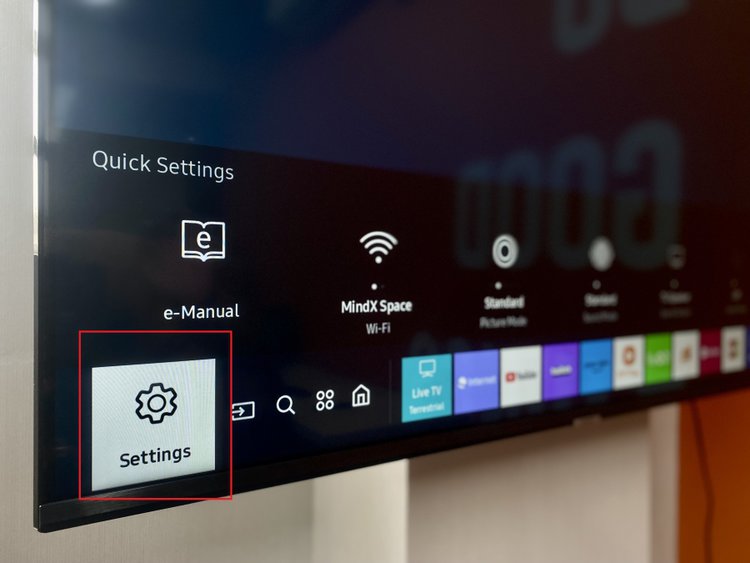
Step 3: Click on General and go to External Device Manager.
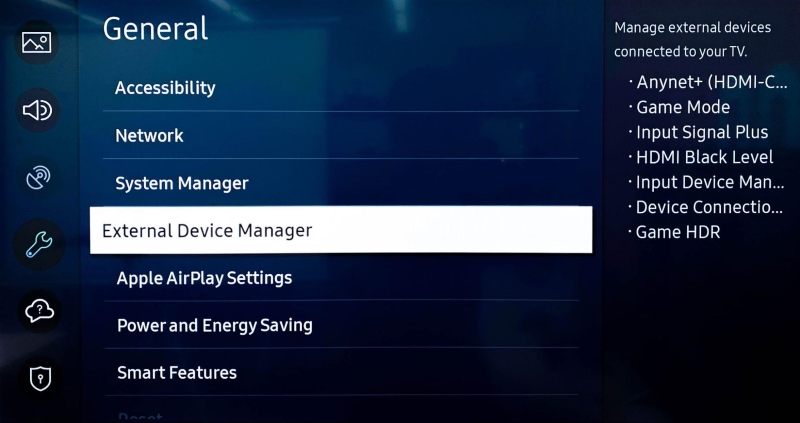
Step 4: Navigate to Input Signal Plus.
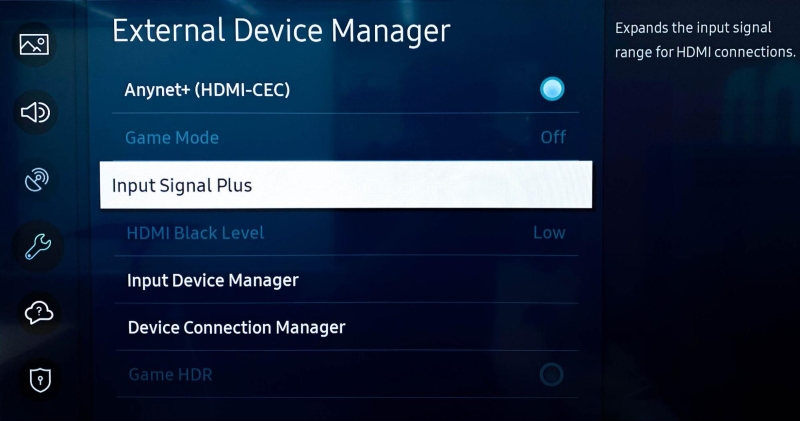
Step 5: Enable the HDMI port connected to your PC or laptop.
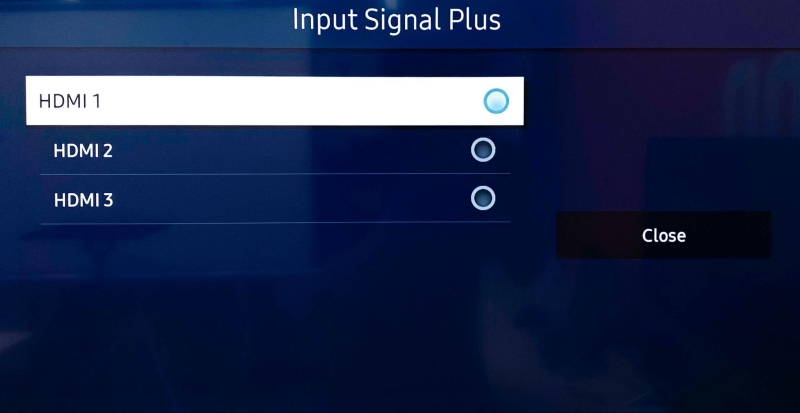
Step 6: From here, adjust your PC or laptop’s HDR/SDR brightness by following the instructions outlined in my comprehensive guide.
Streaming Device (Apple TV, Roku)
Several users found that their Samsung TV’s screen suddenly darkened when they plugged a streaming device such as an Apple TV into it to watch streaming platforms (e.g. Netflix) in HDR.
Your Samsung TV may be labeled “HDR compatible” but it may not be bright enough to actually display HDR content from the streaming devices, leading to a dark screen.
To learn more about how HDR content can make your Samsung TV’s screen appear dim, check out our article Why Do 4K HDR Movies Look Dark on Your Display?
SDR content is typically brighter than HDR. So, adjusting your streaming device’s video quality settings to the SDR mode may help brighten your Samsung TV’s screen.
Follow the instructions below to adjust your streaming device’s video format from HDR to SDR.
Apple TV
Step 1: Head to the Menu screen and click on Settings.
Step 2: Go to the Video and Audio tab.
Step 3: Head to the Video section and select Format.
Step 4: From here, you can adjust the Format from HDR to any format you desire.
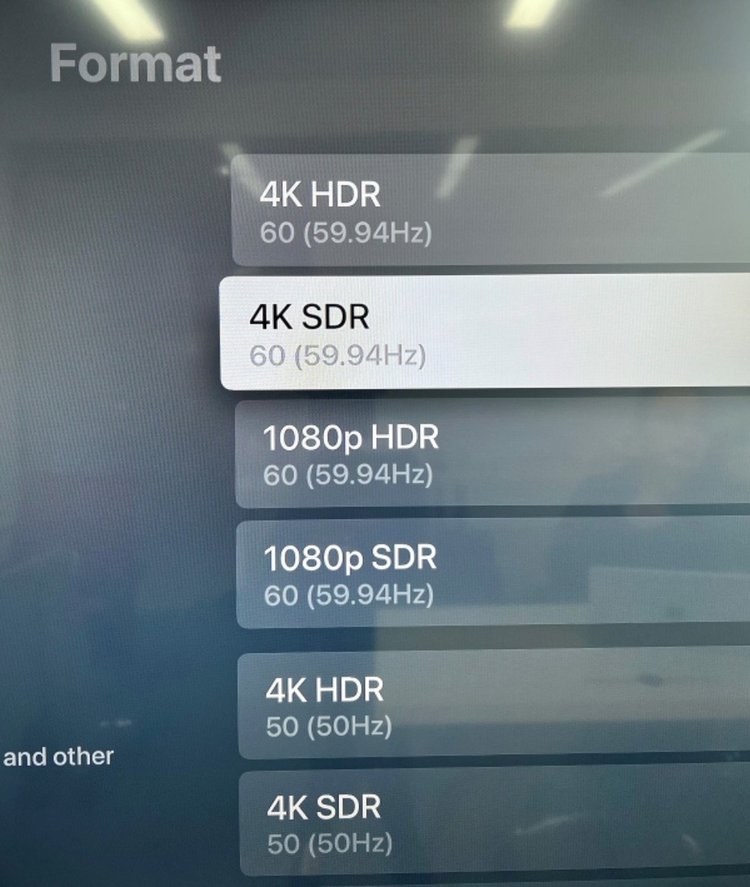
Roku
Step 1: Hit your remote’s Home button to go to the Home screen.
Step 2: Head to the Settings in the left side menu.
Step 3: Scroll down and click on Display type.
Step 4: Now, you can select a non-HDR display type from the options.
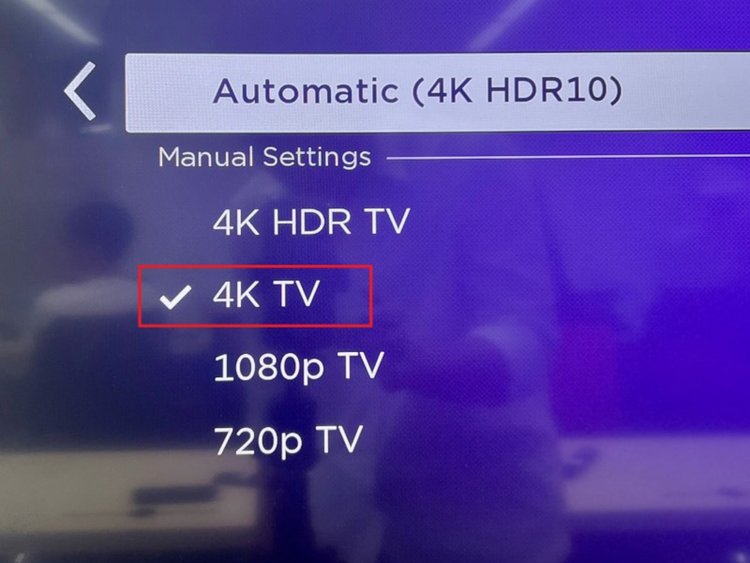
Learn more about adjusting your Apple TV and Roku’s video quality settings by reading our article How to Turn Off Dolby Vision on TVs & Streaming Devices?
Wrapping Things Up
Samsung TVs boast high brightness settings, but certain hardware or setting issues can cause your TV to look unusually dim.
In some cases, your TV may even become dark once you connect an external device such as a laptop or a streaming device to it.
If your TV is dim or dark in certain areas of the screen, its backlight may be damaged. Luckily, this can be easily fixed by either Samsung, a trusted TV technician, or yourself.
If your streaming device is the culprit, ensure HDR mode is disabled and adjust the device’s display settings.
What’s your experience with your Samsung TV dimming or being too dark?
Let us know in the comments below!
Yesenia Achlim is a technical copywriter and editor with a focus on AV equipment. She aims to break down complicated topics and make technology accessible, no matter your technical expertise. When she’s not teaching you how to replace a projector lamp, you can find her reading and baking.

